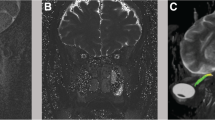Abstract
Purpose
To evaluate the clinical significance of optic chiasmal edema (OCE) observed in hydrocephalus.
Materials and methods
Twenty patients with obstructive hydrocephalus and eight patients with communicating hydrocephalus were recruited. We classified both groups into OCE-positive and negative subgroups on three-dimensional T2-weighted images. In the obstructive hydrocephalus group, the pre- and postoperative periventricular hyperintensity (PVH) grade, Evans index, and third ventricle diameter were compared between the subgroups. The visual disturbances were reviewed in the medical records.
Results
Eleven obstructive hydrocephalus patients (55 %) had OCE, while none of communicating hydrocephalus patients did. OCE was improved in all patients postoperatively. Preoperative PVH grade was significantly higher in the OCE-positive subgroup (p < 0.01). There were no statistically significant differences in the other indices. Visual disturbances were observed in two OCE-negative patients alone.
Conclusion
OCE is a reversible finding frequently observed in obstructive hydrocephalus and may not be associated with visual disturbances.





Similar content being viewed by others
References
Schirmer CM, Hedges TR. Mechanisms of visual loss in papilledema. Neurosurg Focus. 2007;235:E5.
Imamura Y, Mashima Y, Oshitari K, Oguchi Y, Momoshima S, Shiga H. Detection of dilated subarachnoid space around the optic nerve in patients with papilloedema using T2 weighted fast spin echo imaging. J Neurol Neurosurg Psychiatry. 1996;601:108–9.
Towbin R, Garcia-Revillo J, Fitz C. Orbital hydrocephalus: a proven cause for optic atrophy. Pediatr Radiol. 1998;2812:995–7.
Singh I, Haris M, Husain M, Husain N, Rastogi M, Gupta RK. Role of endoscopic third ventriculostomy in patients with communicating hydrocephalus: an evaluation by MR ventriculography. Neurosurg Rev. 2008;313:319–25.
Shinohara Y, Tohgi H, Hirai S, Terashi A, Fukuuchi Y, Yamaguchi T, et al. Effect of the Ca antagonist nilvadipine on stroke occurrence or recurrence and extension of asymptomatic cerebral infarction in hypertensive patients with or without history of stroke (PICA Study). 1. Design and results at enrollment. Cerebrovasc Dis. 2007;242–3:202–9.
Evans WA. An encephalographic ratio for estimating ventricular enlargement and cerebral atrophy. Arch Neurol Psychiatry. 1942;476:931.
Synek V, Reuben JR, Du Boulay GH. Comparing Evans’ index and computerized axial tomography in assessing relationship of ventricular size to brain size. Neurology. 1976;263:231–3.
Wilhelm H, Grodd W, Schiefer U, Zrenner E. Uncommon chiasmal lesions: demyelinating disease, vasculitis, and cobalamin deficiency. Ger J Ophthalmol. 1993;24–5:234–40.
Ning X, Xu K, Luo Q, Qu L, Yu J. Uncommon cavernous malformation of the optic chiasm: a case report. Eur J Med Res. 2012;17:24.
Nagahata M, Hosoya T, Kayama T, Yamaguchi K. Edema along the optic tract: a useful MR finding for the diagnosis of craniopharyngiomas. AJNR Am J Neuroradiol. 1998;199:1753–7.
Zimmerman RD, Fleming CA, Lee BC, Saint-Louis LA, Deck MD. Periventricular hyperintensity as seen by magnetic resonance: prevalence and significance. AJR Am J Roentgenol. 1986;1463:443–50.
Ho M-L, Rojas R, Eisenberg RL. Cerebral edema. AJR Am J Roentgenol. 1993;2012:W258–73.
Wozniak M, McLone DG, Raimondi AJ. Micro- and macrovascular changes as the direct cause of parenchymal destruction in congenital murine hydrocephalus. J Neurosurg. 1975;435:535–45.
Takashi H, Satoshi M. Hydrocephalus- foundations and clinics. Tokyo: NEURON Publishing Co., LTD.; 1992. p. 81–90.
Standring S. Gray’s anatomy: the anatomical basis of clinical practice. 40th ed. London: Churchill Livingstone; 2008. p. 237–45.
Tokiwa Kaichi, Akira Kurata YM. The probable cause of visual field defects secondary to obstructive hydrocephalus: an analysis of six cases. Jpn J Neurosurg. 1993;2:128–32.
Holsgrove D, Leach P, Herwadkar A, Gnanalingham KK. Visual field deficit due to downward displacement of optic chiasm. Acta Neurochir. 2009;151(8):995–7.
Humphrey PR, Moseley IF, Russell RW. Visual field defects in obstructive hydrocephalus. J Neurol Neurosurg Psychiatry. 1982;457:591–7.
Jung NY, Moon W-J, Lee MH, Chung EC. Magnetic resonance cisternography: comparison between 3-dimensional driven equilibrium with sensitivity encoding and 3-dimensional balanced fast-field echo sequences with sensitivity encoding. J Comput Assist Tomogr. 2007;314:588–91.
Stanisz GJ, Odrobina EE, Pun J, Escaravage M, Graham SJ, Bronskill MJ, et al. T1, T2 relaxation and magnetization transfer in tissue at 3T. Magn Reson Med. 2005;54:507–12.
Conflict of interest
The authors declare no grant or conflict of interest associated with this manuscript.
Ethical standard
All procedures were in accordance with the ethical standards of institutional review board and with the Helsinki Declaration of 1975, as revised in 2008.
Author information
Authors and Affiliations
Corresponding author
About this article
Cite this article
Hiyama, T., Masumoto, T., Shiigai, M. et al. Optic chiasmal edema observed on T2-weighted MR images: a reversible finding in obstructive hydrocephalus. Jpn J Radiol 33, 140–145 (2015). https://doi.org/10.1007/s11604-015-0393-6
Received:
Accepted:
Published:
Issue Date:
DOI: https://doi.org/10.1007/s11604-015-0393-6




